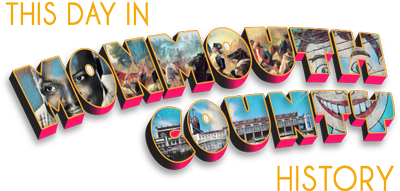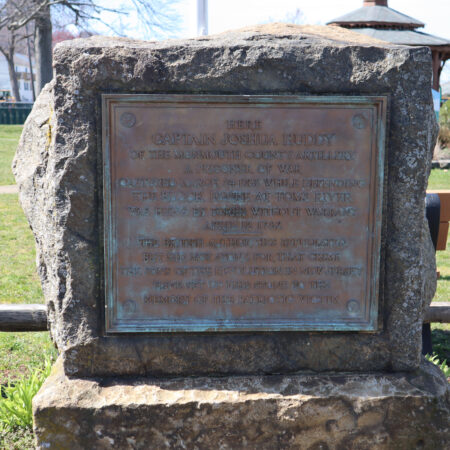When a group of Middletowners discovered Huddy’s body hanging from a makeshift gallows on a spring day in 1782, an overturned barrel at his feet and a vengeful placard on his breast, they had no idea that Huddy’s death would precipitate what has been called the first international incident in the then-brief history of the United States. Huddy, an officer of the New Jersey State Troops, had been captured in a devastating Loyalist raid on Toms River and was subsequently imprisoned in Manhattan, where he expected to be eventually freed in exchange for a freed Loyalist prisoner. The “exchange” occurred, but not as Huddy thought: with the apparent approval of the Board of Associated Loyalists, a paramilitary group established with the grudging authorization of the British commander-in-chief, Loyalist Captain Richard Lippincott took Huddy from his cell and commanded a subordinate to execute him on the New Jersey coast, as 16 other Tories looked on (the commemorative marker pictured above in Highlands marks the spot near where Huddy was lynched).
The note affixed to Huddy’s corpse expressed the Loyalist view that Huddy’s hanging was just retribution for Patriot atrocities and in particular for the death of Philip White, a captured Loyalist raider killed under suspicious circumstances on the way to prison. However vicious their resolution to “hang man for man,” the Loyalists were justified in their anger: a faction of Patriot extremists known as the Association for Retaliation had indeed been cutting a bloody swath across Monmouth County, terrorizing Tories and perpetuating a cycle of revenge and counter-revenge on which Huddy’s death, sadly, was not the last word.
Accustomed to thinking of Loyalists as cowards and Patriots as virtuous heroes, the list of alleged Patriot atrocities compiled by the Board of Associated Loyalists to help justify Huddy’s execution offered striking contrasts. Documenting over a dozen cases of cold-blooded murder committed by the “rebels” against the Tories, mostly in Monmouth County, the Loyalists suggested that Huddy and others of his ilk essentially had it coming.
Exaggerated and one-sided as the Loyalist charges were, there was at least some truth to them, considering the numerous acts of vengeance perpetrated by the Association for Retaliation, the Patriot analogue of the Board of Associated Loyalists. Not surprisingly, Huddy comes across quite differently here than he does in Patriot testimonials, no longer a martyr for a just cause but instead a common killer “who acknowledged himself to have been active and assisting in hanging” the Loyalist Stephen Edwards. Edwards, a spy for the British, had been court-martialed and summarily executed after being taken from his bed, where he slept wearing a woman’s night-cap in a vain attempt to disguise himself. According to other Loyalist accounts, Huddy boasted that during Edwards’s execution “he… slushed (meaning greased) the Rope Well, and … assisted in pulling the Rope hand over hand.” If the British had defeated the upstart colonists, we would no doubt see Edwards as the martyr, Huddy the villain.
On April 14, 1782, two days after the lynching, more than 400 people gathered to protest Huddy’s murder and a petition was sent to George Washington demanding retribution. A young British officer, Charles Asgill, was selected by lot to die unless Lippincott was turned over to the Patriots. The British delayed by holding their own court-martial of Lippincott, who was found not guilty on the basis that he was just following orders. The unfortunate Asgill was freed in November by an Act of Congress after Asgill’s mother persuaded the French foreign minister to plead his case to Washington, who was grateful for a way to spare Asgill while saving face for himself and Congress. Like many Tories, Lippincott emigrated to Canada after the war, where the British gave him 3,000 acres as a reward for his services.
Years later, a commemorative bronze tablet was erected on the site of Huddy’s hanging, in a public space called Huddy Park in Highlands. The text on the tablet reads:
HERE
CAPTAIN JOSHUA HUDDY
OF THE MONMOUTH COUNTY ARTILLERY
A PRISONER OF WAR
CAPTURED MARCH 24 1782 WHILE DEFENDING
THE BLOCK HOUSE AT TOMS RIVER
WAS HUNG BY TORIES WITHOUT WARRANT
APRIL 12 1782
——————
THE BRITISH AUTHORITIES REPUDIATED
BUT DID NOT ATONE FOR THAT CRIME
THE SONS OF THE REVOLUTION IN NEW JERSEY
HAVE SET UP THIS STONE TO THE
MEMORY OF THE PATRIOTIC VICTIM
Sources:
Saretzky, Gary D. (2004). THE JOSHUA HUDDY ERA: Documents of the American Revolution. Catalog of the Exhibition at Monmouth County Library Headquarters, Manalapan, N.J. October, 2004; Revised November 2004. Produced by the Monmouth County Archives. Available: https://www.monmouthcountyclerk.com/archives/events-exhibits/2004-documents-of-the-american-revolution-joshua-huddy-era/
Image credit: John R. Barrows


Leave a Reply